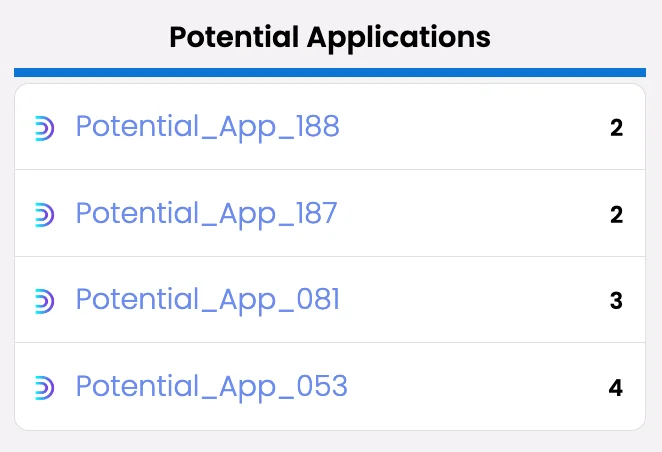Inventory Mapping

The Inventory Mapping section helps you map servers to application workloads
Overview
The Inventory Mapping functionality allows you to map servers to known application workloads either by using the AI-assisted Auto Map feature or by uploading existing CMDB data through the Bulk Upload option. These tools streamline the process of identifying and mapping servers to relevant workloads, ensuring accurate and efficient migration.
This guide will walk you through the two main approaches to inventory mapping:
Auto Map (AI Assistance)
The Auto Map feature utilizes AI to automatically map discovered servers to application workloads, significantly reducing the manual effort required for configuration. This method is ideal for situations where you want a quick, intelligent mapping based on your environment’s current data.
Access Auto Map
From the CMDB Assistant dashboard, select the Auto Map option under “Select your Mapping Approach.”
AI Assistant Mapping
The system will automatically begin mapping servers to relevant applications based on the discovered workloads. The results will display:
- Number of Application Workloads discovered
- Number of Servers Mapped to an application
- Any Potential Applications for further review
Review the Auto-Map Results
The results will show a breakdown of IT tools, security & compliance applications, modern workplace tools, and line-of-business software that has been automatically mapped. Use the legend to understand which items are included, excluded, or newly detected in the mapping process.
Understanding AutoMap Icons:
- A yellow lightning bolt icon indicates there are unmapped servers available for that technology. These servers will be included in the AutoMap process.
- A grey lightning bolt icon means all servers for that technology are already mapped to applications. AutoMap will skip these servers unless explicitly told to overwrite existing mappings.
AutoMap will never automatically overwrite existing application mappings without your specific permission.
Additional Options

AI mapping interface with additional options
After reviewing the results, you can:
- Undo Auto-Map Mappings if you want to revert the mapping
- Refresh Auto-Map Candidates to rerun the auto-mapping with new data
- Refresh Potential Applications to review any suggested application workloads that were flagged for review
Unlock Advanced Insights
Once mappings are complete, advanced reporting may be unlocked. Click View Insights to access in-depth analysis of your mappings and workloads.
Bulk Upload
The Bulk Upload feature allows you to upload your existing CMDB data and map servers to application workloads in bulk. This method is recommended if you have a comprehensive set of data readily available and want to map multiple servers at once.
Select your Mapping Approach
Go to the CMDB Assistant dashboard and choose the Bulk Upload option under “Select your Mapping Approach.”
Download Bulk Upload Template
Click Download Pre-Filled Template to obtain a bulk upload template that includes:
- Discovered servers
- Operating system information
- VM descriptions
- SQL detection status
Complete the Template
Fill in the template with the necessary mapping information based on your CMDB data.
Upload Your Completed Template
After completing the template, upload it via one of the following options:
- Option A: Upload directly to your storage account
- Option B: Upload via a secure link provided
Unlock Advanced Insights
Once the template is uploaded, click View Insights to access reporting on the mapped servers and application workloads.
Potential Application Review
After running the Auto Map process, you may need to review potential applications suggested by the AI engine. This section explains how to validate and complete server mappings through the Potential Application Review functionality.
Accessing Potential Application Review
When reviewing a potential application (e.g., Potential_App_110), you will be presented with several key details that assist in identifying and validating server mappings.
View Potential Applications
Select the potential application you’d like to view to examine its details and proceed with mapping.

Review and manage potential application mappings
Select Mapping Tab
Select the ‘Map Servers’ tab on the left-hand side.
AI Analysis
The AI Analysis tab provides an overview of the AI engine’s confidence in the server mappings related to the potential application. Here’s what to review:
Key metrics to consider:
- Number of Servers: Displays how many servers the AI engine suggests are associated with the application
- Overall Confidence: A percentage score indicating the AI’s confidence in the proposed mapping
Key Indicators:
- Description Similarity: Measures how similar the server descriptions are to known descriptions of the application
- Software Similarity: Compares installed software on the servers
- Network Communication: Shows the level of network communication between the servers
- Server Name Similarity: Evaluates the similarity in naming conventions for the servers related to the application
Use these metrics to validate or question the suggested mappings before proceeding to the Server Details tab.
Server Details
The Server Details tab provides a deeper analysis of server-to-server communication and allows you to visualize relationships between servers.
Network Information:
- Purple dots: Servers already mapped to the application
- Blue dots: Potential servers that may be related to this application but are yet to be mapped
The Server List below the network diagram shows:
- Data Health: Status of each server’s health
- Associated Application: Whether the server is mapped to an application
- VM Description: Detailed information on the server’s virtual machine (VM)
- Unique Software: Lists unique software installed on the server
- Environment: Whether the server is associated with an environment (editable in Admin settings)
Map Servers
The Map Servers tab allows you to take action by assigning servers to the appropriate application.
Choose Application
- Enter a new application name, or
- Click + Use Existing Application to select from existing applications
Select Servers
Review the list of servers that can be mapped, showing:
- Server name
- Environment
- Probability score
Save Mapping
Click Save to finalize the mapping after selecting servers and the appropriate application